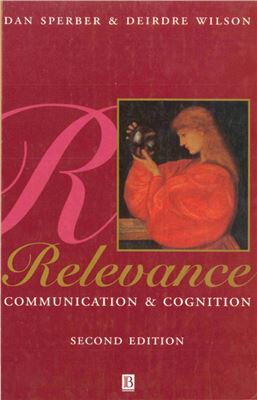(Ebook) Relevance Communication and Cognition. Second Edition by Sperber Dan, Wilson Deidre. ISBN 9780631198789, 0631198784
2nd edition. — Blackwell Publishers, 1996. — 331 p.In this book, first published nine years ago, we present a new approach to the study of human communication. This approach (outlined in chapter 1) is grounded in a general view of human cognition (developed in chapters 2 and 3). Human cognitive processes, we argue, are geared to achieving the greatest possible cognitive effect for the smallest possible processing effort. To achieve this, individuals must focus their attention on what seems to them to be the most relevant information available.To communicate is to claim an individual's attention: hence to communicate is to imply that the information communicated is relevant. This fundamental idea (developed in chapter 3), that communicated information comes with a guarantee of relevance, is what in the First Edition we called the principle of relevance and what we would now call the Second, or Communicative Principle of Relevance (see the Postface to this Second Edition). We argue that this principle of relevance is essential to explaining human communication, and show (in chapter 4) how it is enough on its own to account for the interaction of linguistic meaning and contextual factors in utterance interpretation.Here is how this book came about. In 1975, Deirdre Wilson published Presuppositions and Non-Truth-Conditional Semantics and Dan Sperber published 'Rudiments de rhetorique cognitive', a sequel to his Rethinking Symbolism. In these works, we were both turning to pragmatics - the study of contextual factors in verbal communication - but from different perspectives: Deirdre Wilson was showing how a number of apparently semantic problems could be better solved at a pragmatic level; Dan Sperber was arguing for a view of figures of speech rooted in pragmatics. We then formed the project of writing, in a few months, a joint essay which would cover, at least programmatically, the ground between our two vantage points and show the continuities and discontinuities between semantics, pragmatics and rhetoric. Work did not proceed according to plan. We got involved in carrying out the programme we had merely intended to outline. The months became years. The projected essay became a series of papers and the present book.
*Free conversion of into popular formats such as PDF, DOCX, DOC, AZW, EPUB, and MOBI after payment.


